WORDS TO LIVE BY
FIREFIGHTER QUOTES, TRAINING QUICK TIPS and SIGNATURE MOVES
Extension Ladder | Firefighter Training
In this episode, “Training To Perform Under Pressure” instructor, Adam Ritsch provides an overview of ground ladders and their limitations, providing firefighters with knowledge of their weapon. VIDEO TRANSCRIPTION: Have y’all seen how they test these things? Typically test it annually. They’ve been the living mess out ’em. They put a giant weight in the middle and they flex this
Roof Ladder | Firefighter Training
In this episode, “Training To Perform Under Pressure” instructor, Adam Ritsch gives an overview of “knowing your weapon” when it comes to the roof ladder. VIDEO TRANSCRIPTION: What’s kind of unique about that straight ladder or the roof ladder? Hooks on both ends, and you’ve got the butt spurs on both ends, right? Really, really nice. It’s, it’s bi-directional at
Make A Drill | Firefighter Training
In this episode, “Training To Perform Under Pressure” instructor, Adam Ritsch encourages firefighters to set up a drill at their stations to train in their own environment. VIDEO TRANSCRIPTION: Train well with ladders. Don’t just throw to an empty brick wall and be like, yep, we’re good. We covered it for the month. You’ll notice in the fire service is
The Paxton Drill | Firefighter Training
In this episode, “Training To Perform Under Pressure” instructor, Adam Ritsch instructs firefighters regarding knowing how your ladders and your district match up. Firefighters in this drill are required to throw six ladders to six different windows in two minutes. VIDEO TRANSCRIPTION: You shouldn’t just be throwing ladders to windows with no rhyme or reason. You should know exactly what
History Behind The Paxton Drill | Firefighter Training
In this episode, “Training To Perform Under Pressure” instructor, Adam Ritsch, explains the history behind the Paxton Drill, dating back to a fire in Chicago where dozens of victims were rescued from ladders upon arrival. VIDEO TRANSCRIPTION: You shouldn’t just be throwing ladders to windows with no rhyme or reason. You should know exactly what ladders you have and based
Thermal Imaging Camera – Live Fire Reading | Firefighter Training
In the final episode of the four-part Thermal Imaging Camera (TIC) training video series, “Training To Perform Under Pressure” instructor, Mike McCarthy, instructs firefighters on how to utilize and read a TIC while in a structure fire environment. VIDEO TRANSCRIPTION: Camera’s on, you’re gonna see that incipient stage quickly transfer to growth, right? Incipient stage. What does that give us?
Thermal Imaging Camera – Recognizing Fire Below | Firefighter Training
In the third episode of the four-part Thermal Imaging Camera (TIC) training video series, “Training To Perform Under Pressure” instructor, Mike McCarthy, instructs firefighters on how to utilize a TIC to determine if a fire is beneath you in a structure. VIDEO TRANSCRIPTION: So now looking at it, what’s the hottest thing? My hand or the carpet? About equal, right?
Thermal Imaging Camera – Predicting Flowpath | Firefighter Training
In the second episode of the four-part Thermal Imaging Camera (TIC) training video series, “Training To Perform Under Pressure” instructor, Mike McCarthy, provides tips surrounding the use of a TIC to determine where a fire has been at, where it is at now and where it is going based on the flowpath. VIDEO TRANSCRIPTION: Are we seeing any convective currents
Thermal Imaging Camera – Go Or No Go | Firefighter Training
In the opening episode of the four-part Thermal Imaging Camera (TIC) training video series, “Training To Perform Under Pressure” instructor, Mike McCarthy, provides tips surrounding the use of a TIC for making decisions on the fireground. VIDEO TRANSCRIPTION: We got everyone looking at the front. Do yourselves a favor. If you’ve got a camera, take a lap around the back.
Aerial Operation – Short Jacking & Struts | Firefighter Training
In the final part of the fire truck tower ladder training video series, “Training To Perform Under Pressure” instructor, Steve Ripley, A.K.A. “Rip”, provides tips on how to utilize your equipment on the fireground without hindering operations for your department. VIDEO TRANSCRIPTION: Ground pads. Y’all have policies about ground pads in your department? Always go down. Okay. What about setting,
Aerial Operation – Straight Stick | Firefighter Training
In part 4 of the fire truck tower ladder training video series, “Training To Perform Under Pressure” instructor, Steve Ripley, A.K.A. “Rip”, features the advantages and limitations of a straight stick aerial. VIDEO TRANSCRIPTION: Steve Ripley. Most people call me rip. Easy to remember. I love ladder truck work. Most of my career has been spent on special pieces. Let’s
Aerial Operation – Buckets, Limbs and Saws | Firefighter Training
In part 3 of the fire truck tower ladder training video series, “Training To Perform Under Pressure” instructor, Steve Ripley, A.K.A. “Rip”, instructs firefighters how to navigate hazards when on the fireground. VIDEO TRANSCRIPTION: Let’s talk about the tower. Alright. It’s a beast of a truck. Aluminum ladder. Big bucket. Nice working area. Alright, so we’ll work off this today.
Aerial Operation – Hand Signals | Firefighter Training
In this series of fire truck tower ladder training videos, “Training To Perform Under Pressure” instructor, Steve Ripley, A.K.A. “Rip”, provides firefighters non-verbal communication skills for the fireground when working with an aerial apparatus. VIDEO TRANSCRIPTION: Hand signals. What do we think this means? Lower or come down. If that mic’s not working, I want to use my hand signals.
Aerial Operations Tower Ladder Bucket Drill | Firefighter Training
In this fire truck tower ladder training video, “Training To Perform Under Pressure” instructor, Steve Ripley, A.K.A. “Rip”, instructs firefighters through a cone tapping drill that helps operators establish the necessary skills they need to be precise with an aerial bucket. This drill is useful for rescues, navigating small areas or performing technical rescues. VIDEO TRANSCRIPTION: This one here is
“I put the ads back on the door about six inches, slide punch the tip to my target. That takes me to where I need to be every time.”
Todd Shepard | Forge Fire & Company
Forced Entry Tip
“The best tool you can have is a Home Depot paint stick. And we just wrap Velcro on the, on the handle of it.”
Brian Bird | Arvada Auto X Instructor
HEAVY LIFTING/Rescue Tool Tip
“What we don’t want to do is put the chain with the hook down because now you have to remember we’re pulling down on this car. Take the chain and bury the hook into the car.”
Paul Shoemaker | Next Level Extrication
Motor Vehicle/Rescue Tool Tip
If I keep the spreader tip flat down to start, I’m going to be able to go a lot higher with stability of this thing being on the ground and being flat.
Paul Shoemaker | Next Level Extrication
Motor Vehicle/Rescue Tool Tip
“We keep our cutters on our right side because we lay on our left. And then, we put ’em in the correct way, which is handles down and the heads up.”
Paul Capo | When Things Go Bad, Inc
Self Rescue
Forced Entry Through a Padlock Using the Two-Person Hook Method
Based on “IFSTA Essentials of Firefighting 7th Edition” Forced Entry
Forced Entry Through a Padlock: One-person Twist Method
Based on “IFSTA Essentials of Firefighting 7th Edition” Forced Entry
Don’t send your firefighter up with a bundle of line. He or she needs to go up and over handsfree. They can force entry, they can start figuring out the layout, as your officer comes and hands the bundle over.
Lead-Advance-Stretch Instructor, Instructor, Leo Mel
Structure Fire
“When you set up on a real building, don’t just set it up, pull it back down and leave. Set it up, climb up there and look at the actual transition”
Magic City Truck Academy, LLC Instructor, William Knight
Structure Fire
“Add a Halligan to the butt spur end so that it counterbalances the hooks”
Magic City Truck Academy Instructor, OJ Kolodziej
Structure Fire
‘”Strike” perpendicularly incase you miss, but try not to miss.’
— Paul Capo, When Things Go Bad, Inc. instructor FORCIBLE ENTRY
“They have shown that when you give yourself mental messages, your nervous system goes from the threat response, where you want to rip off your mask and get the hell out of there, to the challenge response, where your body is like, ‘F!@k ya, lets do this’. All because of what you say to yourself in your brain.”
— Olivia Mead, CEO and Founder of Yoga for First Responders MENTAL HEALTH
“You’ve got control of your nervous system if you’ve got control of your breath.”
— Olivia Mead, CEO and Founder of Yoga for First Responders MENTAL HEALTH
“You get them out of that atmosphere as quick as possible and sometimes that is the window. You need to have that plan available from the very beginning.”
Search OR Rescue Awareness Structure Fire
‘A quarter of the length of the ladder is where you want to be from the building for proper climbing angle.’
Ladder Throwing Tip Structure Fire
“Don’t call for water until you have (the line) flaked out how you like it.”
Hose Management in 5-Story Stairwell
Hose Management
‘The weight of the coupling will suck this whole line down so we’ve got to tie this off. We’re always gonna tie it off below the coupling.’
Hose Management in 5-Story Stairwell
Hose Management
‘If you feel that 50 foot coupling in your hand, you should be the fifth floor. If you’re at the third floor and here’s the coupling, you have a pile on the ground, so don’t let more flake off your shoulders as you walk up.’
Hose Management in 5-Story Stairwell
Hose Management
‘Take the nozzle. Advance and pin the hose to the ground so you don’t lose control of it. Then using your big muscles, pull it up the stairs.’
Two Person Hose Team Upstairs – ‘When Things Go Bad’
Hose Management
To move from standing… you’re not walking with it, you’re stepping forward. Always leaving a nice strong base deep and wide, never crossing over with your feet. The transition from there, is down to your knee, then right back to the same position.
Two Person Hose Team – ‘When Things Go Bad’
Hose Management
LIFT: Determine where the fire is
LIFE: Check for life in the immediate area
LAYOUT: Look for anything to help hose team get inside the building more efficiently
Jake Dickes, Son’s of Irons Instructor
Structure Fire
“Make sure our extrication is patient driven and not ego driven.”
Beaver Lane Fire & Rescue Chief, Toranze Lee
Vehicle Extrication
“Think of a Ratchet as a Gear Shift”
Ratchet Training
Vehicle Stabilization
“‘Never put your hand in the mouth of an alligator. Always stick them in the ass.’ So wrap it from the back, that way you keep your hands out.”
Ratchet Training
Vehicle Stabilization
“When you need length and strength, you need to go to the Paratechs.”
Nick Griffin, Beaver Lane Fire Department — Heavy Lifting and Stabilization Training
Vehicle Stabilization
“That (truck) has a high carbon steel frame. It’s made to twist and turn, or else if it didn’t it would break. If you got enough anchor points, you can get a lot more twist out of that frame on that truck then you realize.”
Nick Griffin, Beaver Lane Fire Department — Heavy Lifting and Stabilization Training
Vehicle Stabilization
“Webbing is going to elongate. Chain is not. So if I throw chain in and I ratchet it down to capture that suspension, I know it’s not going anywhere.”
Heavy Lifting and Stabilization Training at Secrest Wrecker Service — Monroe, NC
Vehicle Stabilization
“The King Ring is the ring you want to attach too if you can. It’s gonna provide the most strength that we can have.”
Heavy Lifting and Stabilization Training at Secrest Wrecker Service — Monroe, NC
Vehicle Stabilization
“Cars are really just beer cans and pop cans. They crush down onto the victim. To get the victim out, you don’t need to put the pop can back to where it was.”
IndyCar Dr. Andrew Stevens, Colorado State Firefighters Association 2021 — Parker, CO
Vehicle Extrication
“When you’re off duty, be off duty.”
— Andy Starnes | Instructor and Founder at Insight Fire Training LLC
Self-Rescue
“Start at the top and wrap down. If I start at the bottom and wrap up, (the rope) binds on itself because it comes over.”
— Parker CO, Fire College | “When things go bad”
Rapid Intervention -Stairwell Rescue
“So many people don’t see victims as victims because of how they perceive a prostitute.”
— iEmpathize | Addressing Human Trafficking Victims Training Course
Human Trafficking Confrontation
“When you are putting a chain on the strut, put the welded piece closest to the strut.”
— Parker CO, Fire College
Vehicle Stabilization
“When in doubt, cheat out”
— Parker CO, Fire College | Rescue 42’s
Vehicle Stabilization
“Beware of airbag cylinders.”
— Parker CO, Fire College | Team Holmatro
Vehicle Extrication
“You want to do diagonal cuts on your seatbelts. If you don’t cut seatbelts when you’re doing the blowout or the laydown, they will hang you up every time.”
— Parker CO, Fire College
Vehicle Extrication
“A space containing more than 23.5% of oxygen is enriched and enhances combustible flammability”
— Tim Johnson, Confined Space Instructor
CONFINED SPACE
“We’re not lifting the dash 18 inches like the textbook training. A lot of times people’s feet are pinned underneath the dash, we’re just trying to get the dash to where it used to be.”
— Parker CO, Fire College
Vehicle Extrication
“If we anchor this (rope) right where the hose is coming off the engine, I know that if I reached the end of my rope, I should be close to the nozzle. I can sweep that area for the nozzle or the men.”
— Parker CO, Fire College
RAPID INTERVENTION
“Pedals are strong front to back. They have no lateral stability. You can just fish in there and hook the webbing around the pedals.”
— Parker CO, Fire College
Vehicle Extrication
“Don’t call for water until you have (the line) flaked out how you like it.”
Hose Management in 5-Story Stairwell
Hose Management
‘The weight of the coupling will suck this whole line down so we’ve got to tie this off. We’re always gonna tie it off below the coupling.’
Hose Management in 5-Story Stairwell
Hose Management
‘If you feel that 50 foot coupling in your hand, you should be the fifth floor. If you’re at the third floor and here’s the coupling, you have a pile on the ground, so don’t let more flake off your shoulders as you walk up.’
Hose Management in 5-Story Stairwell
Hose Management
‘Take the nozzle. Advance and pin the hose to the ground so you don’t lose control of it. Then using your big muscles, pull it up the stairs.’
Two Person Hose Team Upstairs – ‘When Things Go Bad’
Hose Management
To move from standing… you’re not walking with it, you’re stepping forward. Always leaving a nice strong base deep and wide, never crossing over with your feet. The transition from there, is down to your knee, then right back to the same position.
Two Person Hose Team – ‘When Things Go Bad’
Hose Management
LIFT: Determine where the fire is
LIFE: Check for life in the immediate area
LAYOUT: Look for anything to help hose team get inside the building more efficiently
Jake Dickes, Son’s of Irons Instructor
Structure Fire
“I put the ads back on the door about six inches, slide punch the tip to my target. That takes me to where I need to be every time.”
Todd Shepard | Forge Fire & Company
Forced Entry Tip
‘”Strike” perpendicularly incase you miss, but try not to miss.’
— Paul Capo, When Things Go Bad, Inc. instructor FORCIBLE ENTRY
“The best tool you can have is a Home Depot paint stick. And we just wrap Velcro on the, on the handle of it.”
Brian Bird | Arvada Auto X Instructor
HEAVY LIFTING/Rescue Tool Tip
“What we don’t want to do is put the chain with the hook down because now you have to remember we’re pulling down on this car. Take the chain and bury the hook into the car.”
Paul Shoemaker | Next Level Extrication
Motor Vehicle/Rescue Tool Tip
If I keep the spreader tip flat down to start, I’m going to be able to go a lot higher with stability of this thing being on the ground and being flat.
Paul Shoemaker | Next Level Extrication
Motor Vehicle/Rescue Tool Tip
“Make sure our extrication is patient driven and not ego driven.”
Beaver Lane Fire & Rescue Chief, Toranze Lee
Vehicle Extrication
“Think of a Ratchet as a Gear Shift”
Ratchet Training
Vehicle Stabilization
“‘Never put your hand in the mouth of an alligator. Always stick them in the ass.’ So wrap it from the back, that way you keep your hands out.”
Ratchet Training
Vehicle Stabilization
“That (truck) has a high carbon steel frame. It’s made to twist and turn, or else if it didn’t it would break. If you got enough anchor points, you can get a lot more twist out of that frame on that truck then you realize.”
Nick Griffin, Beaver Lane Fire Department — Heavy Lifting and Stabilization Training
Vehicle Stabilization
“When you need length and strength, you need to go to the Paratechs.”
Nick Griffin, Beaver Lane Fire Department — Heavy Lifting and Stabilization Training
Vehicle Stabilization
“Webbing is going to elongate. Chain is not. So if I throw chain in and I ratchet it down to capture that suspension, I know it’s not going anywhere.”
Heavy Lifting and Stabilization Training at Secrest Wrecker Service — Monroe, NC
Vehicle Stabilization
“The King Ring is the ring you want to attach too if you can. It’s gonna provide the most strength that we can have.”
Heavy Lifting and Stabilization Training at Secrest Wrecker Service — Monroe, NC
Vehicle Stabilization
“Cars are really just beer cans and pop cans. They crush down onto the victim. To get the victim out, you don’t need to put the pop can back to where it was.”
IndyCar Dr. Andrew Stevens, Colorado State Firefighters Association 2021 — Parker, CO
Vehicle Extrication
“When you are putting a chain on the strut, put the welded piece closest to the strut.”
— Parker CO, Fire College
Vehicle Stabilization
“When in doubt, cheat out”
— Parker CO, Fire College | Rescue 42’s
Vehicle Stabilization
“Beware of airbag cylinders.”
— Parker CO, Fire College | Team Holmatro
Vehicle Extrication
“You want to do diagonal cuts on your seatbelts. If you don’t cut seatbelts when you’re doing the blowout or the laydown, they will hang you up every time.”
— Parker CO, Fire College
Vehicle Extrication
“We’re not lifting the dash 18 inches like the textbook training. A lot of times people’s feet are pinned underneath the dash, we’re just trying to get the dash to where it used to be.”
— Parker CO, Fire College
Vehicle Extrication
“Pedals are strong front to back. They have no lateral stability. You can just fish in there and hook the webbing around the pedals.”
— Parker CO, Fire College
Vehicle Extrication
“We keep our cutters on our right side because we lay on our left. And then, we put ’em in the correct way, which is handles down and the heads up.”
Paul Capo | When Things Go Bad, Inc
Self Rescue
“Start at the top and wrap down. If I start at the bottom and wrap up, (the rope) binds on itself because it comes over.”
— Parker CO, Fire College | “When things go bad”
Rapid Intervention -Stairwell Rescue
“If we anchor this (rope) right where the hose is coming off the engine, I know that if I reached the end of my rope, I should be close to the nozzle. I can sweep that area for the nozzle or the men.”
— Parker CO, Fire College
RAPID INTERVENTION
Aerial Operation – Short Jacking & Struts | Firefighter Training
In the final part of the fire truck tower ladder training video series, “Training To Perform Under Pressure” instructor, Steve Ripley, A.K.A. “Rip”, provides tips on how to utilize your equipment on the fireground without hindering operations for your department. VIDEO TRANSCRIPTION: Ground pads. Y’all have policies about ground pads in your department? Always go down. Okay. What about setting,
Aerial Operation – Straight Stick | Firefighter Training
In part 4 of the fire truck tower ladder training video series, “Training To Perform Under Pressure” instructor, Steve Ripley, A.K.A. “Rip”, features the advantages and limitations of a straight stick aerial. VIDEO TRANSCRIPTION: Steve Ripley. Most people call me rip. Easy to remember. I love ladder truck work. Most of my career has been spent on special pieces. Let’s
Aerial Operation – Buckets, Limbs and Saws | Firefighter Training
In part 3 of the fire truck tower ladder training video series, “Training To Perform Under Pressure” instructor, Steve Ripley, A.K.A. “Rip”, instructs firefighters how to navigate hazards when on the fireground. VIDEO TRANSCRIPTION: Let’s talk about the tower. Alright. It’s a beast of a truck. Aluminum ladder. Big bucket. Nice working area. Alright, so we’ll work off this today.
Aerial Operation – Hand Signals | Firefighter Training
In this series of fire truck tower ladder training videos, “Training To Perform Under Pressure” instructor, Steve Ripley, A.K.A. “Rip”, provides firefighters non-verbal communication skills for the fireground when working with an aerial apparatus. VIDEO TRANSCRIPTION: Hand signals. What do we think this means? Lower or come down. If that mic’s not working, I want to use my hand signals.
Aerial Operations Tower Ladder Bucket Drill | Firefighter Training
In this fire truck tower ladder training video, “Training To Perform Under Pressure” instructor, Steve Ripley, A.K.A. “Rip”, instructs firefighters through a cone tapping drill that helps operators establish the necessary skills they need to be precise with an aerial bucket. This drill is useful for rescues, navigating small areas or performing technical rescues. VIDEO TRANSCRIPTION: This one here is
“I put the ads back on the door about six inches, slide punch the tip to my target. That takes me to where I need to be every time.”
Todd Shepard | Forge Fire & Company
Forced Entry Tip
“The best tool you can have is a Home Depot paint stick. And we just wrap Velcro on the, on the handle of it.”
Brian Bird | Arvada Auto X Instructor
HEAVY LIFTING/Rescue Tool Tip
“What we don’t want to do is put the chain with the hook down because now you have to remember we’re pulling down on this car. Take the chain and bury the hook into the car.”
Paul Shoemaker | Next Level Extrication
Motor Vehicle/Rescue Tool Tip
If I keep the spreader tip flat down to start, I’m going to be able to go a lot higher with stability of this thing being on the ground and being flat.
Paul Shoemaker | Next Level Extrication
Motor Vehicle/Rescue Tool Tip
Forced Entry Through a Padlock Using the Two-Person Hook Method
Based on “IFSTA Essentials of Firefighting 7th Edition” Forced Entry
Forced Entry Through a Padlock: One-person Twist Method
Based on “IFSTA Essentials of Firefighting 7th Edition” Forced Entry
“Add a Halligan to the butt spur end so that it counterbalances the hooks”
Magic City Truck Academy Instructor, OJ Kolodziej
Structure Fire
‘”Strike” perpendicularly incase you miss, but try not to miss.’
— Paul Capo, When Things Go Bad, Inc. instructor FORCIBLE ENTRY
“Think of a Ratchet as a Gear Shift”
Ratchet Training
Vehicle Stabilization
“‘Never put your hand in the mouth of an alligator. Always stick them in the ass.’ So wrap it from the back, that way you keep your hands out.”
Ratchet Training
Vehicle Stabilization
“That (truck) has a high carbon steel frame. It’s made to twist and turn, or else if it didn’t it would break. If you got enough anchor points, you can get a lot more twist out of that frame on that truck then you realize.”
Nick Griffin, Beaver Lane Fire Department — Heavy Lifting and Stabilization Training
Vehicle Stabilization
“When you need length and strength, you need to go to the Paratechs.”
Nick Griffin, Beaver Lane Fire Department — Heavy Lifting and Stabilization Training
Vehicle Stabilization
“When you are putting a chain on the strut, put the welded piece closest to the strut.”
— Parker CO, Fire College
Vehicle Stabilization
“When in doubt, cheat out”
— Parker CO, Fire College | Rescue 42’s
Vehicle Stabilization
“We keep our cutters on our right side because we lay on our left. And then, we put ’em in the correct way, which is handles down and the heads up.”
Paul Capo | When Things Go Bad, Inc
Self Rescue
“They have shown that when you give yourself mental messages, your nervous system goes from the threat response, where you want to rip off your mask and get the hell out of there, to the challenge response, where your body is like, ‘F!@k ya, lets do this’. All because of what you say to yourself in your brain.”
— Olivia Mead, CEO and Founder of Yoga for First Responders MENTAL HEALTH
“You’ve got control of your nervous system if you’ve got control of your breath.”
— Olivia Mead, CEO and Founder of Yoga for First Responders MENTAL HEALTH
“When you’re off duty, be off duty.”
— Andy Starnes | Instructor and Founder at Insight Fire Training LLC
Self-Rescue
Extension Ladder | Firefighter Training
In this episode, “Training To Perform Under Pressure” instructor, Adam Ritsch provides an overview of ground ladders and their limitations, providing firefighters with knowledge of their weapon. VIDEO TRANSCRIPTION: Have y’all seen how they test these things? Typically test it annually. They’ve been the living mess out ’em. They put a giant weight in the middle and they flex this
Roof Ladder | Firefighter Training
In this episode, “Training To Perform Under Pressure” instructor, Adam Ritsch gives an overview of “knowing your weapon” when it comes to the roof ladder. VIDEO TRANSCRIPTION: What’s kind of unique about that straight ladder or the roof ladder? Hooks on both ends, and you’ve got the butt spurs on both ends, right? Really, really nice. It’s, it’s bi-directional at
Make A Drill | Firefighter Training
In this episode, “Training To Perform Under Pressure” instructor, Adam Ritsch encourages firefighters to set up a drill at their stations to train in their own environment. VIDEO TRANSCRIPTION: Train well with ladders. Don’t just throw to an empty brick wall and be like, yep, we’re good. We covered it for the month. You’ll notice in the fire service is
The Paxton Drill | Firefighter Training
In this episode, “Training To Perform Under Pressure” instructor, Adam Ritsch instructs firefighters regarding knowing how your ladders and your district match up. Firefighters in this drill are required to throw six ladders to six different windows in two minutes. VIDEO TRANSCRIPTION: You shouldn’t just be throwing ladders to windows with no rhyme or reason. You should know exactly what
History Behind The Paxton Drill | Firefighter Training
In this episode, “Training To Perform Under Pressure” instructor, Adam Ritsch, explains the history behind the Paxton Drill, dating back to a fire in Chicago where dozens of victims were rescued from ladders upon arrival. VIDEO TRANSCRIPTION: You shouldn’t just be throwing ladders to windows with no rhyme or reason. You should know exactly what ladders you have and based
Thermal Imaging Camera – Live Fire Reading | Firefighter Training
In the final episode of the four-part Thermal Imaging Camera (TIC) training video series, “Training To Perform Under Pressure” instructor, Mike McCarthy, instructs firefighters on how to utilize and read a TIC while in a structure fire environment. VIDEO TRANSCRIPTION: Camera’s on, you’re gonna see that incipient stage quickly transfer to growth, right? Incipient stage. What does that give us?
Thermal Imaging Camera – Recognizing Fire Below | Firefighter Training
In the third episode of the four-part Thermal Imaging Camera (TIC) training video series, “Training To Perform Under Pressure” instructor, Mike McCarthy, instructs firefighters on how to utilize a TIC to determine if a fire is beneath you in a structure. VIDEO TRANSCRIPTION: So now looking at it, what’s the hottest thing? My hand or the carpet? About equal, right?
Thermal Imaging Camera – Predicting Flowpath | Firefighter Training
In the second episode of the four-part Thermal Imaging Camera (TIC) training video series, “Training To Perform Under Pressure” instructor, Mike McCarthy, provides tips surrounding the use of a TIC to determine where a fire has been at, where it is at now and where it is going based on the flowpath. VIDEO TRANSCRIPTION: Are we seeing any convective currents
Thermal Imaging Camera – Go Or No Go | Firefighter Training
In the opening episode of the four-part Thermal Imaging Camera (TIC) training video series, “Training To Perform Under Pressure” instructor, Mike McCarthy, provides tips surrounding the use of a TIC for making decisions on the fireground. VIDEO TRANSCRIPTION: We got everyone looking at the front. Do yourselves a favor. If you’ve got a camera, take a lap around the back.
Aerial Operation – Short Jacking & Struts | Firefighter Training
In the final part of the fire truck tower ladder training video series, “Training To Perform Under Pressure” instructor, Steve Ripley, A.K.A. “Rip”, provides tips on how to utilize your equipment on the fireground without hindering operations for your department. VIDEO TRANSCRIPTION: Ground pads. Y’all have policies about ground pads in your department? Always go down. Okay. What about setting,
Aerial Operation – Straight Stick | Firefighter Training
In part 4 of the fire truck tower ladder training video series, “Training To Perform Under Pressure” instructor, Steve Ripley, A.K.A. “Rip”, features the advantages and limitations of a straight stick aerial. VIDEO TRANSCRIPTION: Steve Ripley. Most people call me rip. Easy to remember. I love ladder truck work. Most of my career has been spent on special pieces. Let’s
Aerial Operation – Buckets, Limbs and Saws | Firefighter Training
In part 3 of the fire truck tower ladder training video series, “Training To Perform Under Pressure” instructor, Steve Ripley, A.K.A. “Rip”, instructs firefighters how to navigate hazards when on the fireground. VIDEO TRANSCRIPTION: Let’s talk about the tower. Alright. It’s a beast of a truck. Aluminum ladder. Big bucket. Nice working area. Alright, so we’ll work off this today.
Aerial Operation – Hand Signals | Firefighter Training
In this series of fire truck tower ladder training videos, “Training To Perform Under Pressure” instructor, Steve Ripley, A.K.A. “Rip”, provides firefighters non-verbal communication skills for the fireground when working with an aerial apparatus. VIDEO TRANSCRIPTION: Hand signals. What do we think this means? Lower or come down. If that mic’s not working, I want to use my hand signals.
Aerial Operations Tower Ladder Bucket Drill | Firefighter Training
In this fire truck tower ladder training video, “Training To Perform Under Pressure” instructor, Steve Ripley, A.K.A. “Rip”, instructs firefighters through a cone tapping drill that helps operators establish the necessary skills they need to be precise with an aerial bucket. This drill is useful for rescues, navigating small areas or performing technical rescues. VIDEO TRANSCRIPTION: This one here is
Don’t send your firefighter up with a bundle of line. He or she needs to go up and over handsfree. They can force entry, they can start figuring out the layout, as your officer comes and hands the bundle over.
Lead-Advance-Stretch Instructor, Instructor, Leo Mel
Structure Fire
“When you set up on a real building, don’t just set it up, pull it back down and leave. Set it up, climb up there and look at the actual transition”
Magic City Truck Academy, LLC Instructor, William Knight
Structure Fire
“Add a Halligan to the butt spur end so that it counterbalances the hooks”
Magic City Truck Academy Instructor, OJ Kolodziej
Structure Fire
‘”Strike” perpendicularly incase you miss, but try not to miss.’
— Paul Capo, When Things Go Bad, Inc. instructor FORCIBLE ENTRY
“You get them out of that atmosphere as quick as possible and sometimes that is the window. You need to have that plan available from the very beginning.”
Search OR Rescue Awareness Structure Fire
‘A quarter of the length of the ladder is where you want to be from the building for proper climbing angle.’
Ladder Throwing Tip Structure Fire
“Don’t call for water until you have (the line) flaked out how you like it.”
Hose Management in 5-Story Stairwell
Hose Management
‘The weight of the coupling will suck this whole line down so we’ve got to tie this off. We’re always gonna tie it off below the coupling.’
Hose Management in 5-Story Stairwell
Hose Management
‘If you feel that 50 foot coupling in your hand, you should be the fifth floor. If you’re at the third floor and here’s the coupling, you have a pile on the ground, so don’t let more flake off your shoulders as you walk up.’
Hose Management in 5-Story Stairwell
Hose Management
‘Take the nozzle. Advance and pin the hose to the ground so you don’t lose control of it. Then using your big muscles, pull it up the stairs.’
Two Person Hose Team Upstairs – ‘When Things Go Bad’
Hose Management
To move from standing… you’re not walking with it, you’re stepping forward. Always leaving a nice strong base deep and wide, never crossing over with your feet. The transition from there, is down to your knee, then right back to the same position.
Two Person Hose Team – ‘When Things Go Bad’
Hose Management
LIFT: Determine where the fire is
LIFE: Check for life in the immediate area
LAYOUT: Look for anything to help hose team get inside the building more efficiently
Jake Dickes, Son’s of Irons Instructor
Structure Fire
SIGNATURE FIREGROUND MOVES
Firefighter rescue moves developed by firefighters FOR firefighters.
Slide Punch | Low Vis Forcible Entry
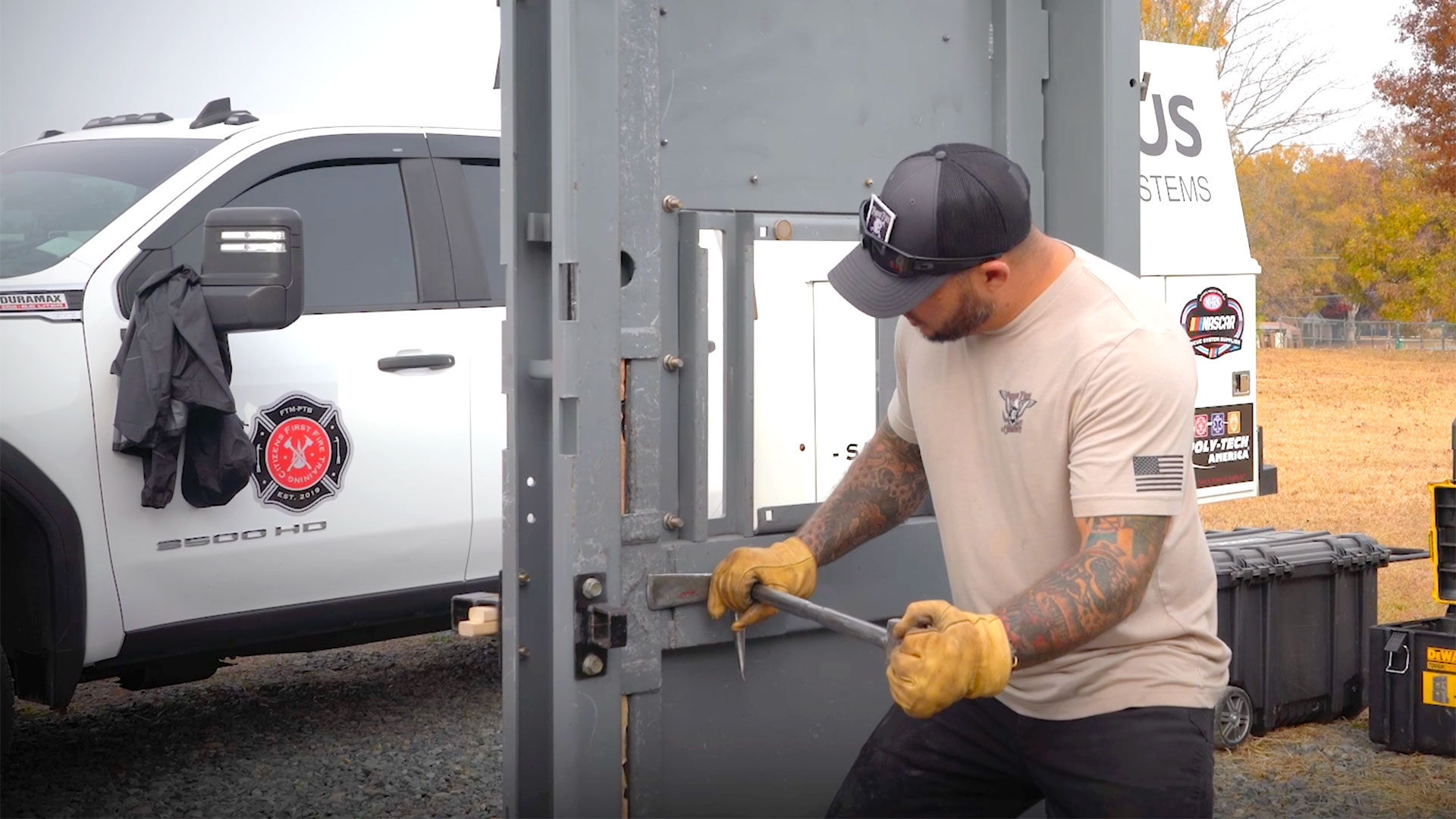
Chicken Wing | Ladder Throw
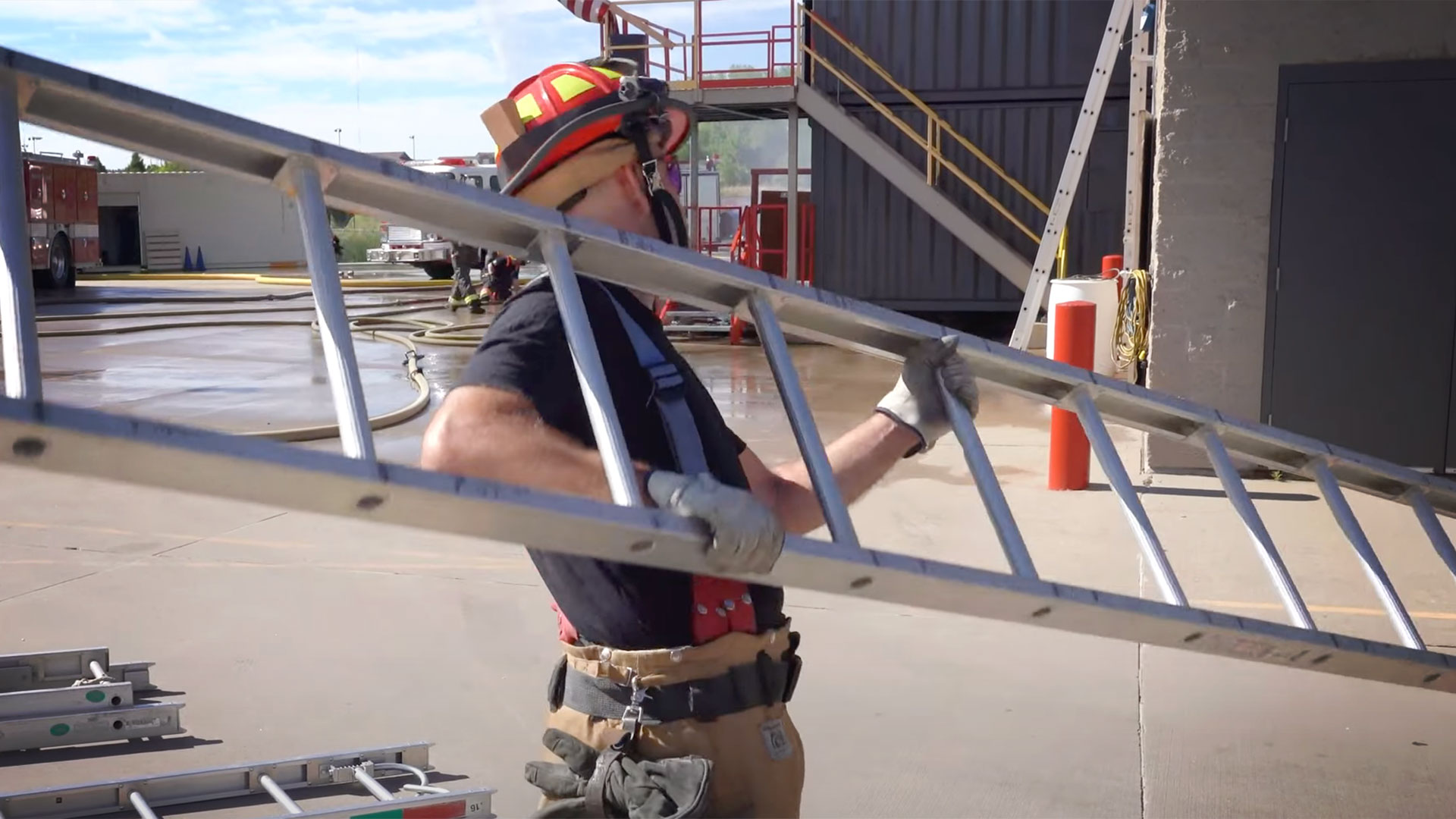
Crib Tilt | V.E.S. (Ventilate, Enter and Search) Scenarios
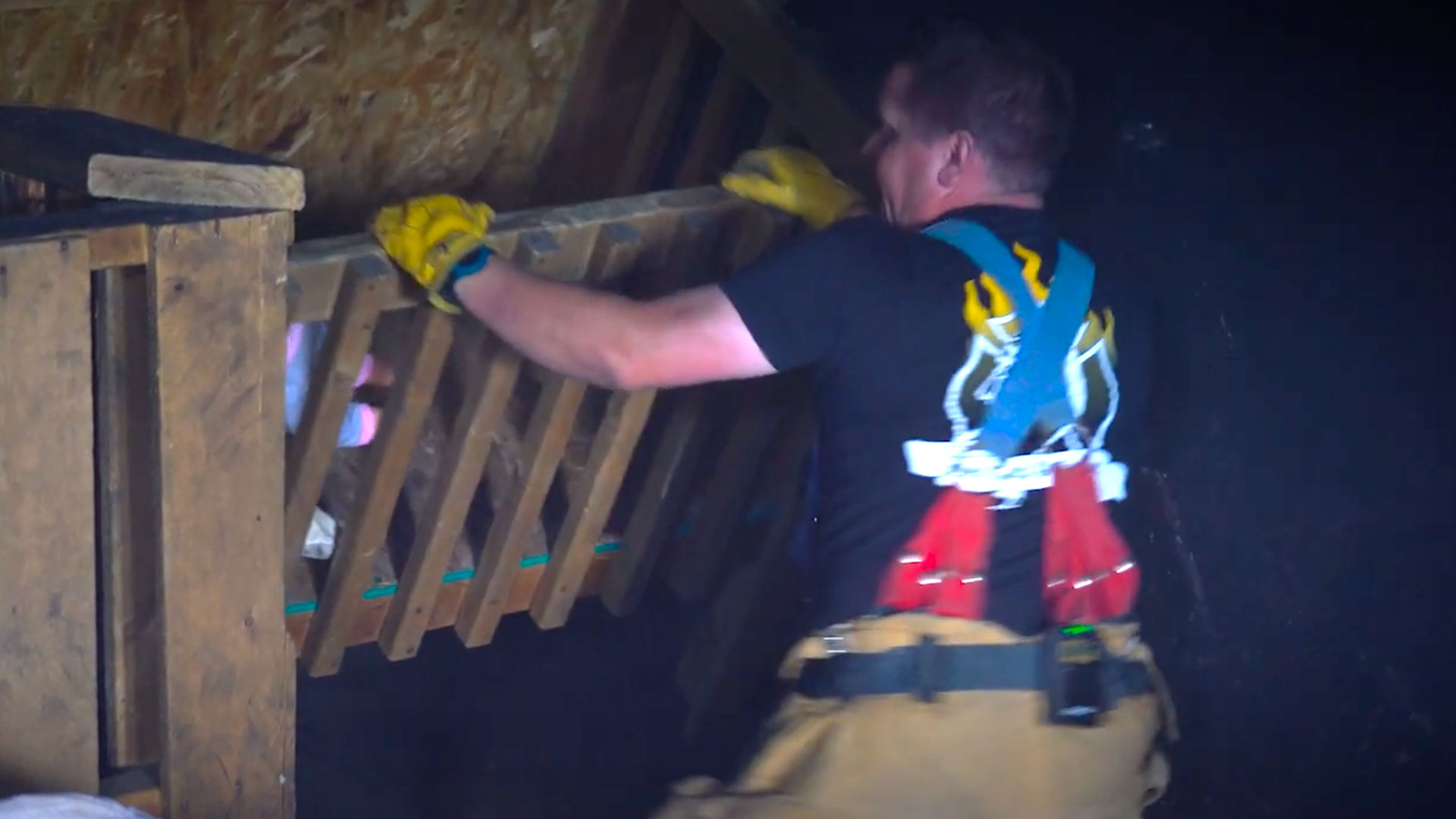
Sheet Pull | V.E.S. (Ventilate, Enter and Search) Scenarios
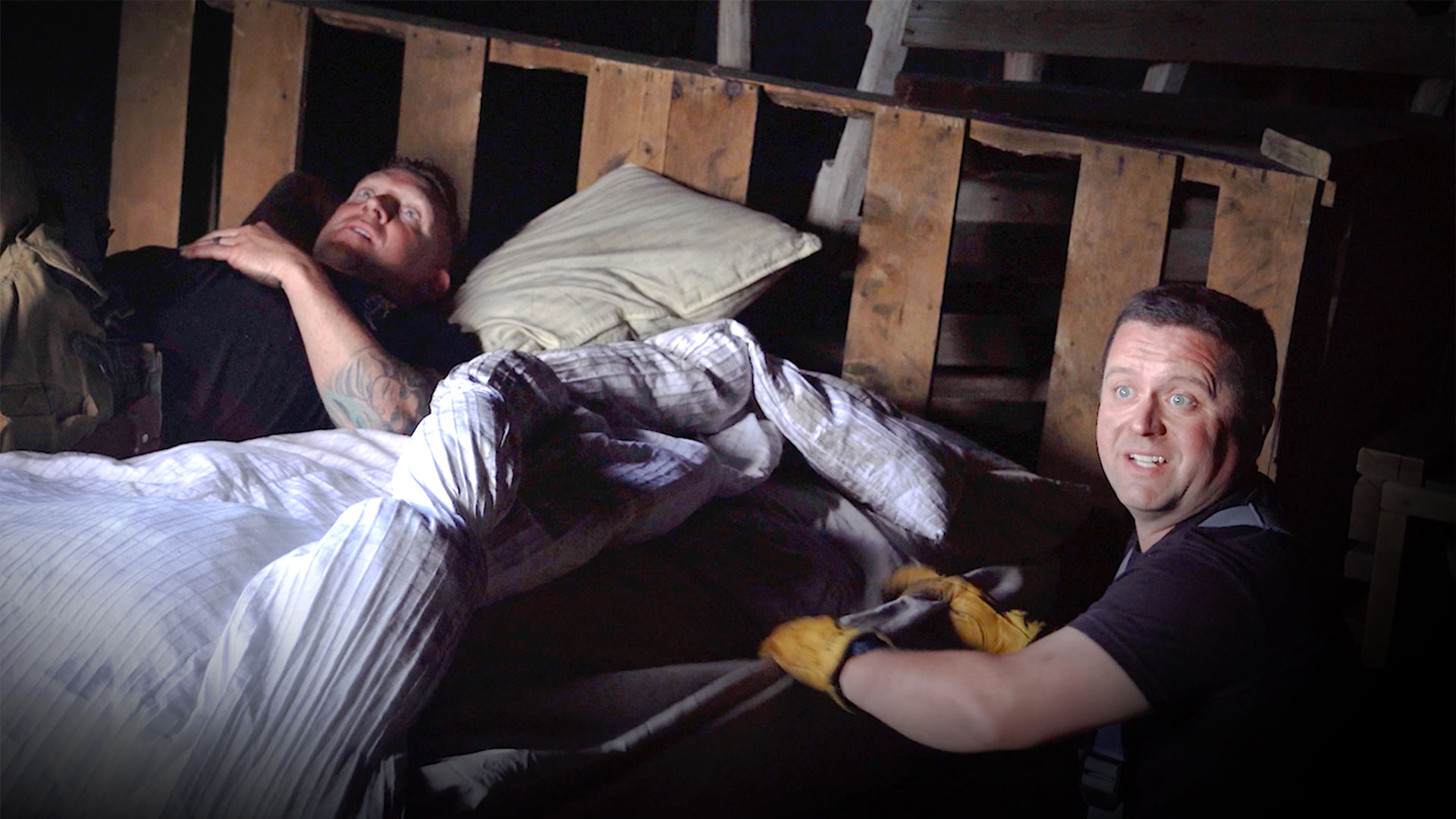
The Monkey Move | V.E.S. (Ventilate, Enter and Search) Scenarios
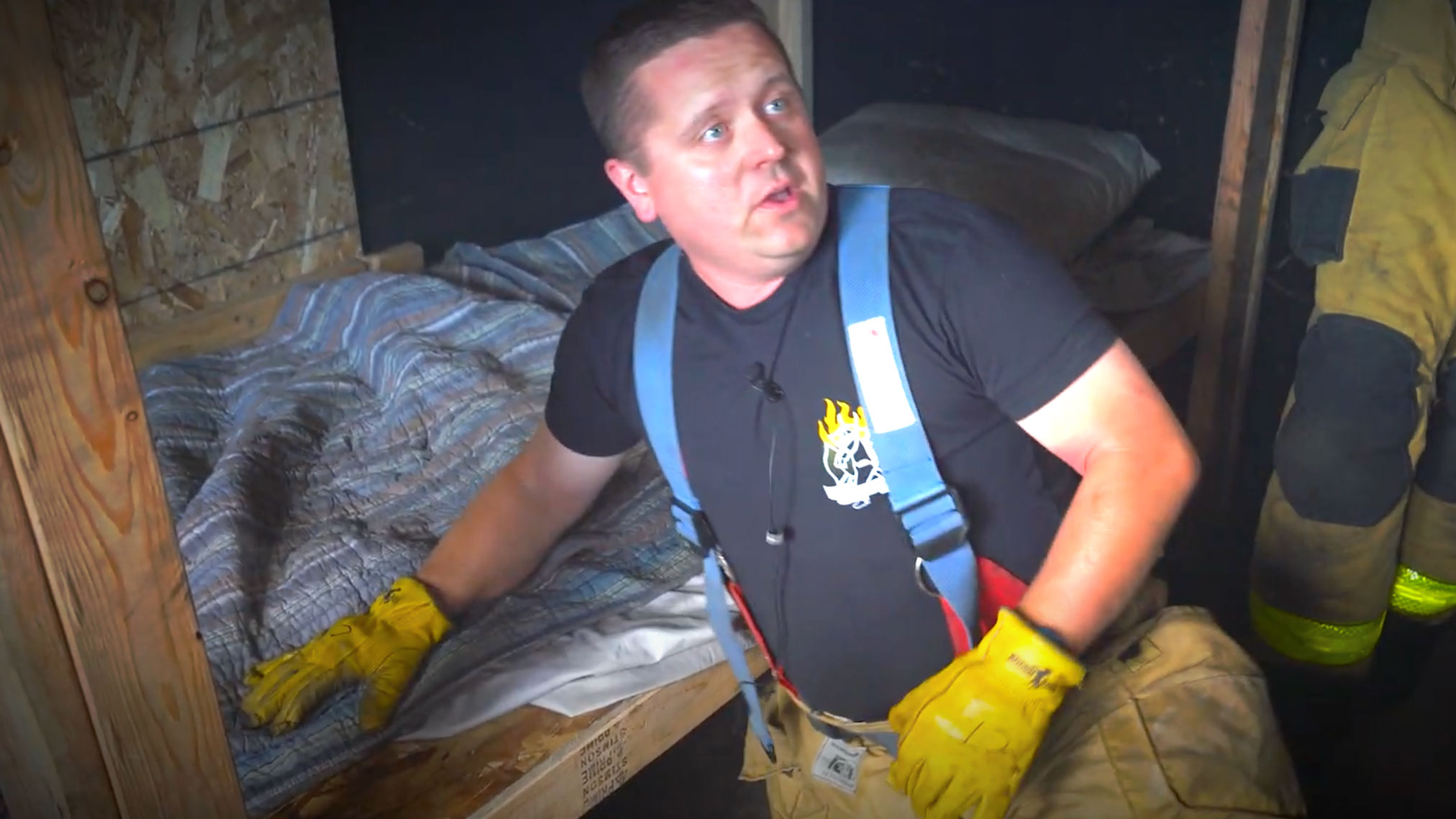
Hug the Rail | Window Rescue Ladder Pass
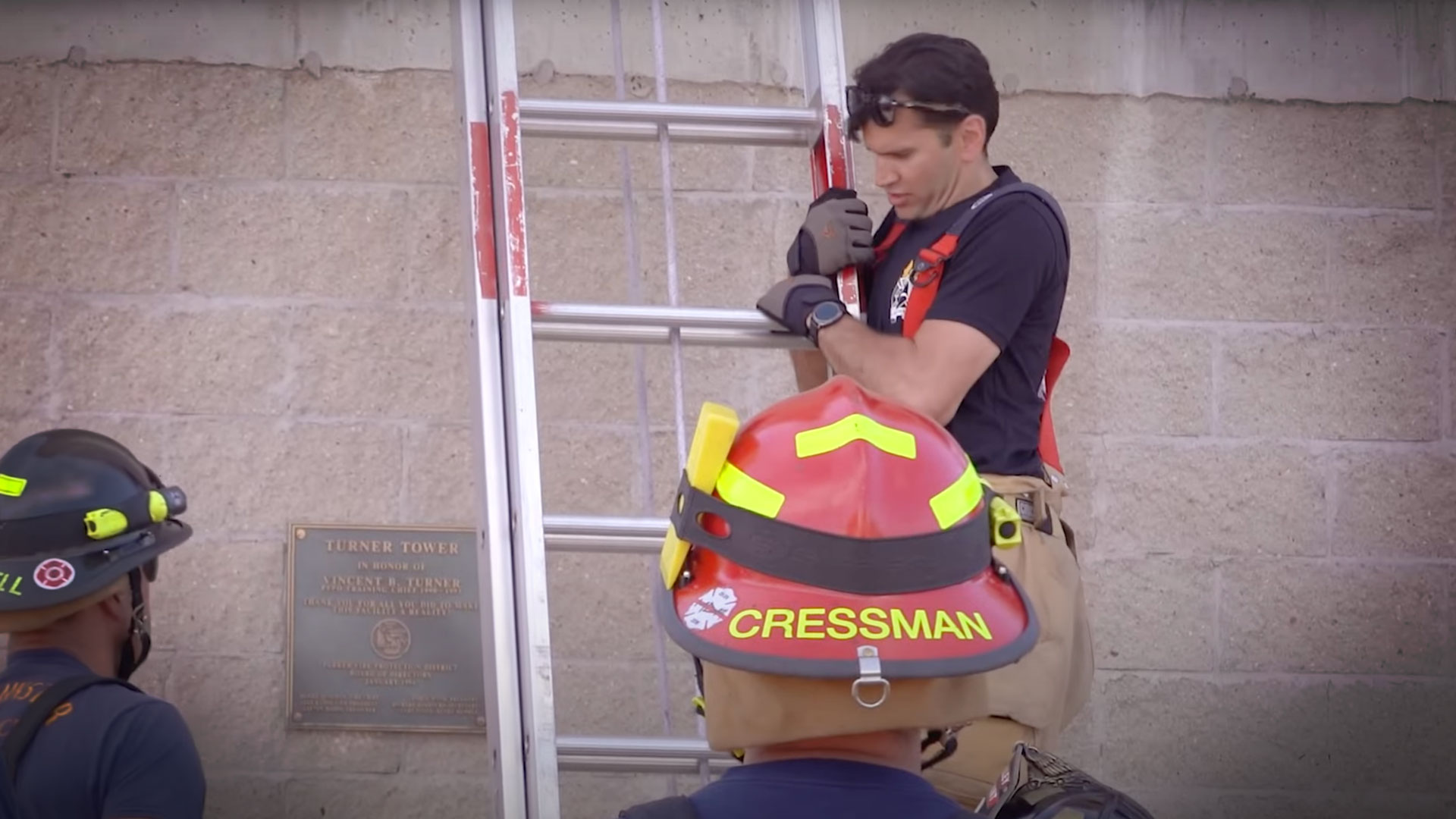
Swim Move | Ladder Window Rescue

Pregnant Lady Lift | Two-Firefighter Rapid Intervention Stairwell Rescue
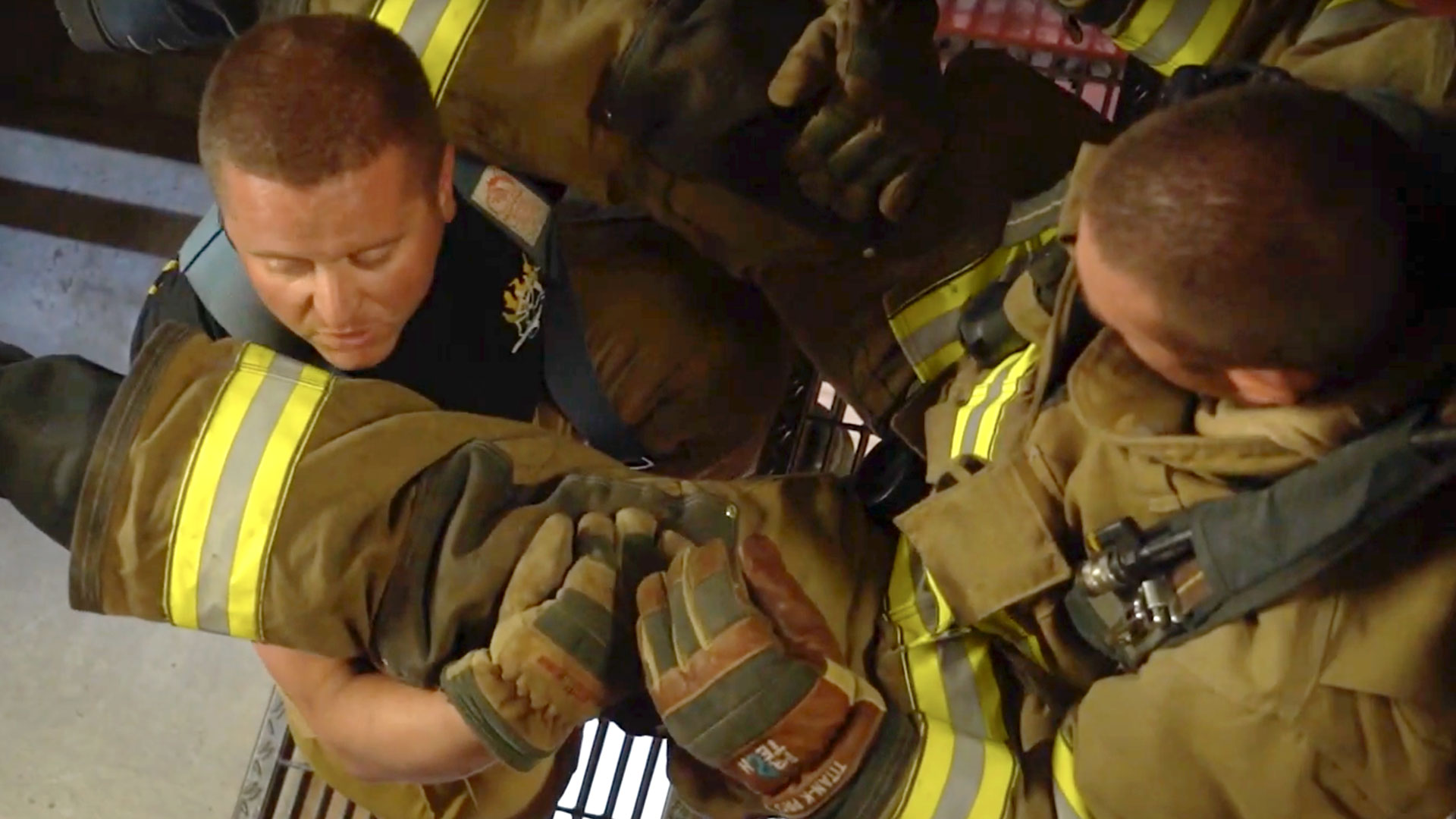
‘Gangsta Move’ | One-Firefighter Stairwell Rescue

FIREFIGHTER QUOTES
Inspirational firefighter quotes to help motivate, guide or simply entertain firefighters.
“The smartest person can’t be the hero.”
— Chris Smity | District of Columbia Fire Department (DCFD)
“Pretty knots operate pretty.”
— Chris Smity | District of Columbia Fire Department (DCFD)
“Search and rescue are not synonymous they shouldn’t even be in the same phrase. It’s search, and then rescue is separate. It’s so often we say search and rescue and never know what to do when we find somebody.”
— Paul Capo, Division Chief Operations and Training, Estes Valley Fire Protection District
“Everything we teach, use it as a buffet table. We all know we go to the buffet bar, ‘Hey I want to try this. I want to try that.’ If I don’t want to try that, I leave it at the table.”
— Chief Toranze Lee | Beaver Lane Fire & Rescue
“When you’re off duty, be off duty.”
— Andy Starnes | Instructor and Founder at Insight Fire Training LLC
Self-Rescue
“Be a thinking firefighter. Don’t be this check the box, minimum PowerPoint instructor, firefighter.”
— Andy Starnes | Instructor and Founder at Insight Fire Training LLC
“Your time underneath this helmet is limited but your time as a servant and as a good human being is not.”
— Andy Starnes | Instructor and Founder at Insight Fire Training LLC
“Give of ourselves to others the greatest gift we could ever give.”
— Andy J. Starnes
“Try before you pry.”
— Instructor, Parker Fire College Instructor




